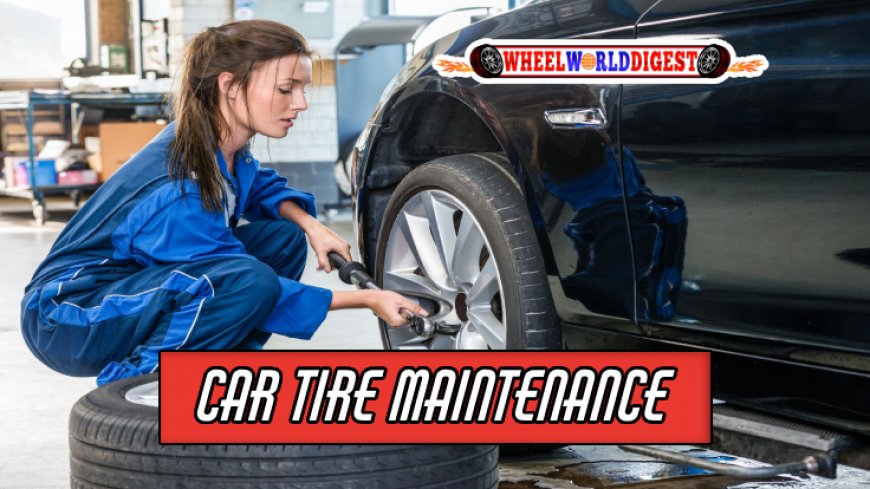All you Need to Know about Car Tire Maintenance
Discover expert maintenance tips and tricks to extend the lifespan of your car tires. Get the most out of your tires with our helpful guide.

Car tire maintenance is critical for longevity and performance on the road. A well-maintained set of tires can provide you with the peace of mind you need every time you hit the road. With proper care, your tires will not only last longer but you'll also enjoy a smoother ride and better fuel efficiency. In this article, we dive deep into the ins and outs of tire care, imparting expert tips on maximizing the lifespan of your valuable rubber companions.
Essentially Car Tire Maintenance
At its core, car tire maintenance revolves around three key areas: the correct tire pressure, regular tire rotations, and periodic visual inspections for damages. But as we dig deeper, you'll find that a thorough understanding of these areas can significantly extend the wear and performance of your tires.
Table of Contents
- The Importance of Car Tire Maintenance
- Maintaining the Correct Tire Pressure
- The Necessity of Regular Tire Rotations
- About Periodic Tire Inspections
- When To Replace Your Car Tires
The Importance of Car Tire Maintenance

When it comes to the base of your vehicle's performance, tires are central. These are not merely black round objects that keep your car off the ground; they are complex features engineered to provide specific handling attributes. Modern car tires are designed to provide a balance of many characteristics; they grip the road, resist heat, wear uniformly, and carry the weight of your vehicle under various driving conditions.
With so many responsibilities in performance, it’s clear that tires call for a certain degree of respect and attention. Here are the three cornerstone reasons as to why car tire maintenance is so significant:
- Safety: Tires in good condition protect you, your passengers, and other road users. Worn or damaged tires can cause driving hazards such as blowouts and loss of control.
- Money-saving: Properly maintained tires last longer, meaning you won’t have to shell out for replacements as often. Plus, they can improve your vehicle's fuel efficiency, helping you save at the pump.
- Laws and regulations: In many regions, it’s illegal to drive with excessively worn or damaged tires. Keeping them in good condition helps you avoid fines or even disqualification.
Maintaining the Correct Tire Pressure

When it comes to car tire maintenance, few things are as critical as keeping them properly inflated. Under-inflated or over-inflated tires can lead to a series of problems such as irregular wear, structural damage, and even tire bursts. Furthermore, tires at the wrong pressure can negatively affect fuel efficiency and handling.
How to Check and Adjust Tire Pressure
To ensure your tires have the right amount of air pressure, you should check them at least once a month and before long trips. Here’s a simple step-by-step guide:
- Get a Tire Pressure Gauge: You can grab one from any auto parts store. Choose from a digital gauge for an accurate reading or a manual dial or stick gauge, which are more budget-friendly.
- Check the Pressure: Remove the tire’s valve cap. Press the gauge onto the valve stem until the hissing sound stops, then read the gauge pressure.
- Compare with the Recommended Pressure: The recommended tire pressure for your car can be found in the vehicle's manual or on a sticker in the driver's side door jamb.
- Adjust Accordingly: If the tire pressure is low, add air until it reaches the recommended level. If it’s too high, let some air out.
The Necessity of Regular Tire Rotations

Tire rotation is an essential part of car tire maintenance, often overlooked by many drivers. Regular rotation helps ensure that your tires wear evenly, elongating their lifespan and giving you smoother rides. Typically, tires should be rotated every 5,000 to 7,500 miles, or according to the vehicle manufacturer's specifications.
"Neglecting tire rotation is like throwing money down the drain," says Aleksandr CarManovich, a veteran automotive technician. "Alongside pressure maintenance, it's the single most impactful measure you can take to prolong the life of your tires."
Understanding Your Car's Tire Rotation Pattern
The pattern of tire rotation can differ based on whether your vehicle is front-wheel drive, rear-wheel drive, or all-wheel drive. Typically, here are the tire rotation patterns:
- Front-Wheel Drive: The front tires are moved directly to the back in the same position. The rear tires are moved diagonally to the front.
- Rear-Wheel Drive: The rear tires are moved straight to the front, and the front tires are moved diagonally to the rear.
- All-Wheel Drive: Tires are rotated diagonally.
About Periodic Tire Inspections
Regular visual inspections are another vital part of car tire maintenance. They can help you identify issues before they become serious problems. When checking your tires, pay attention to three primary areas: tread wear, sidewall condition, and the presence of any foreign objects.
Tread wear: Tire tread provides the necessary grip for safe driving. Over time, it wears down, reducing the vehicle's handling and safety. Most tires come with tread wear indicators built into them. Once the tire tread wears down to these indicators, it's time for replacement. You can also use a coin to measure tread depth; if the top of Lincoln's head is visible when inserted into the tread, it's time for a new tire.
Sidewall condition: Look for cracks, cuts, or bulges on your tire's sidewall. These could indicate structural damage that requires immediate attention.
Foreign objects: Nails, glass shards, or pebbles stuck in the tire can lead to slow leaks or punctures. If you find any such objects, get your tire checked by a professional.
When To Replace Your Car Tires
Knowledge of when to replace your tires is a critical aspect of car tire maintenance. It might be tempting to keep worn tires for "just a few more miles," but this can lead to dangerous and costly consequences. Here are some key indicators that it's time to invest in a new set:
Visible Tread Wear Indicators
As mentioned before, most modern tires come with built-in tread wear indicators. These are small bridges that form between your treads. When your tread wears down to the same level as these bridges, your tires are no longer road-safe, and it's time for a new pair.
Visible Damage: Bulges, Blisters, Cracks
Visible damage around the sides of the wheels is a definite sign you need to replace your tires. Bulges and blisters on the surface are an indicator of weak spots that could soon result in a blowout. Cracks in the sidewall could signify the tire is developing a leak, or worse, it's close to a complete failure.
Excessive Vibration
While some vibration is expected when driving, especially on poorly paved roads, persistent excessive vibrations could indicate that your tires are misaligned, unbalanced, or a sign of internal tire damage.
Consider replacing your tires if they show any of the above symptoms and always have a professional check them if you're unsure. As the only contact point between your vehicle and the road, your tires' health and maintenance should never be compromised, for your bank balance, the law, and mostly, your safety.
A Final Word on Car Tire Maintenance
Remember that car tire maintenance isn't a one-time event but ongoing care. With regular tire pressure monitoring, rotations, visual inspections, and knowing when to say goodbye, you ensure the longevity and performance of your tires, enhancing your driving experience without burning a hole in your pocket. Keep those tires in check!
What's Your Reaction?









































































